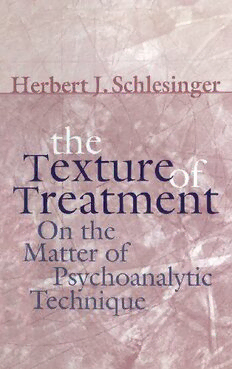
The Texture of Treatment: On the Matter of Psychoanalytic Technique PDF
Preview The Texture of Treatment: On the Matter of Psychoanalytic Technique
The Texture of Treatment Copyrighted Material Copyrighted Material T he Texture of Treatment On the Matter of Psychoanalytic Technique Herbert J. Schlesinger THE ANALYTIC PRESS 2003 Hillsdale, NJ London Copyrighted Material © 2003 by The Analytic Press, Inc., Publishers All rights reserved. No part of this book may be reproduced in any form: by photostat, microform, electronic retrieval system, or any other means, without the prior written permission of the publisher. Published by The Analytic Press, Inc. 101 West Street, Hillsdale, NJ 07642 www.analyticpress.com Library of Congress Cataloging-in-Publication Data Schlesinger, Herbert J The texture of treatment: on the matter of psychoanalytic technique / Herbert J. Schlesinger p. cm. Includes bibliographical references and index. ISBN 0-88163-382-8 1. Psychoanalysis—Methodology. I. Title RC506.S2965 2003 616.89’17—dc22 2003057875 CIP Printed in the United States of America 10 9 8 7 6 5 4 32 Copyrighted Material I dedicate this book to my wife, Ann H. Appelbaum, M.D., whose gentle, persis tent encouragement finally paid off. If only she had allowed herself to be the nagging shrew my procrastinating seemed designed to evoke, this might have been a second or even third edition. Copyrighted Material Copyrighted Material Acknowledgments I want to acknowledge first the contribution of my wife, Ann H. Appelbaum, M.D. Her steadfast encouragement for me to get on with finishing this book and willingness to overlook the many undone house- hold chores were instrumental, especially when I would much rather have shoveled and lifted than write. It does not detract from her contri- bution to note that writing does not deprive us of each other’s company, for we write at adjacent desks, each trying to set a good example for the other. Stanley Goodman, M.D., old friend and colleague, is the sounding board every writer hopes for. He read and commented forcefully, if gen- erally approvingly, on every early version of these chapters, and I adopted his suggestions gratefully. I offered to include his address here so that any reader with a complaint could take it to the proper source, but, with modesty exceeded only by good judgment, he declined. Phil Holzman read several of the chapters, and I profited from his critical observations. Bob Schlesinger caught some obscure allusions and infelicitous expressions that I had missed. If any remain—finders keepers. Over the years, several colleagues, notably Dick Simons, Cal Narcisi, and Diana Diamond, and many students have urged me to clean out my desk drawers of unpublished lectures and put them together as a book. This book draws on the ideas, mostly freshly written, in those lectures and should quiet their urging. John Kerr has been after me to write this book for more years than I care to acknowledge. When finally we arrived at a serious commitment to it, he stayed with the project as editor and matched encouragement with a keen eye and sense of form as well as content. The book owes much to his good taste and clinical as well as literary judgment. Once I had submitted the manuscript, Eleanor Starke Kobrin picked up where John had left off. She caught the slips we had missed and asked the penetrating questions that familiarity with the text had led us to over- look. As a former editor, I appreciate how important is careful editing to converting a good manuscript into an even better book. In both John and vii Copyrighted Material viii Acknowledgments Lenni I found the indispensable passion for quality that marks the best among editors. Finally, I must acknowledge the indispensable contribution of Rudy Ekstein, who surely will recognize that the point of view of this book was inspired by his ancient tutelage and will recall that in our extended conversations was the Ur-source of many of the ideas in it. Copyrighted Material Contents Introduction xi Chapter 1 In the Beginning ... Was Technique 1 Chapter 2 The Systems Approach 13 Chapter 3 Working Principles of Technique 23 Chapter 4 Transference and the Process of Interpretation 47 Chapter 5 Transference and Countertransference 63 Chapter 6 Resistance 81 Chapter 7 Dreams: Royal Road or Scenic Route? 103 Chapter 8 From Listening to Interpretation 117 Chapter 9 The Process of Defense 127 Chapter 10 On Therapeutic Activity 147 Chapter 11 Questioning, Con and Pro 155 Chapter 12 Responding to Patients’ Questions 171 Chapter 13 The Process Point of View 179 Chapter 14 The Place of Regression in Psychoanalysis 189 Chapter 15 The Challenge of Regression 199 Chapter 16 Severe Regression 207 Chapter 17 Analyzing in the Middle Phase 221 Chapter 18 Whether and How to Begin a Psychoanalysis 231 Chapter 19 The Optimal Therapeutic Relationship 249 Chapter 20 Psychoanalysis and Psychoanalytic Psychotherapy 259 Chapter 21 Analyzing and Life Change 267 Chapter 22 Conclusion: Interpretation and Change 277 References 283 Index 288 ix Copyrighted Material
